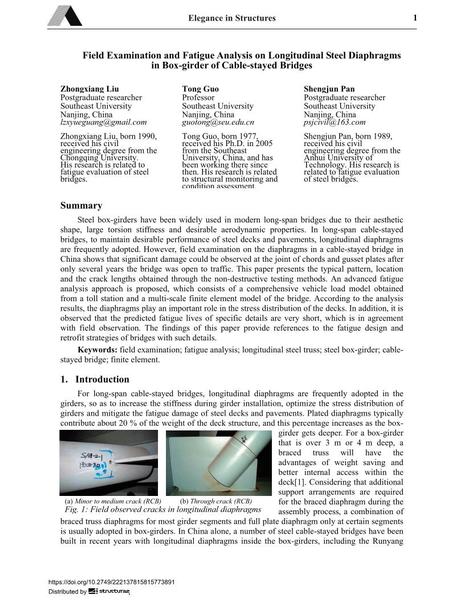Field Examination and Fatigue Analysis on Longitudinal Steel Diaphragms in Box-girder of Cable-stayed Bridges

|
|
|||||||||||
Bibliografische Angaben
| Autor(en): |
Zhongxiang Liu
Tong Guo Shengjun Pan |
||||
|---|---|---|---|---|---|
| Medium: | Tagungsbeitrag | ||||
| Sprache(n): | Englisch | ||||
| Tagung: | IABSE Conference: Elegance in structures, Nara, Japan, 13-15 May 2015 | ||||
| Veröffentlicht in: | IABSE Conference Nara 2015 | ||||
|
|||||
| Seite(n): | 52-53 | ||||
| Anzahl der Seiten (im PDF): | 7 | ||||
| Jahr: | 2015 | ||||
| DOI: | 10.2749/222137815815773891 | ||||
| Abstrakt: |
Steel box-girders have been widely used in modern long-span bridges due to their aesthetic shape, large torsion stiffness and desirable aerodynamic properties. In long-span cable-stayed bridges, to maintain desirable performance of steel decks and pavements, longitudinal diaphragms are frequently adopted. However, field examination on the diaphragms in a cable-stayed bridge in China shows that significant damage could be observed at the joint of chords and gusset plates after only several years the bridge was open to traffic. This paper presents the typical pattern, location and the crack lengths obtained through the non-destructive testing methods. An advanced fatigue analysis approach is proposed, which consists of a comprehensive vehicle load model obtained from a toll station and a multi-scale finite element model of the bridge. According to the analysis results, the diaphragms play an important role in the stress distribution of the decks. In addition, it is observed that the predicted fatigue lives of specific details are very short, which is in agreement with field observation. The findings of this paper provide references to the fatigue design and retrofit strategies of bridges with such details. |
||||
| Stichwörter: |
Ermüdungsberechnung finites Element
|
||||


